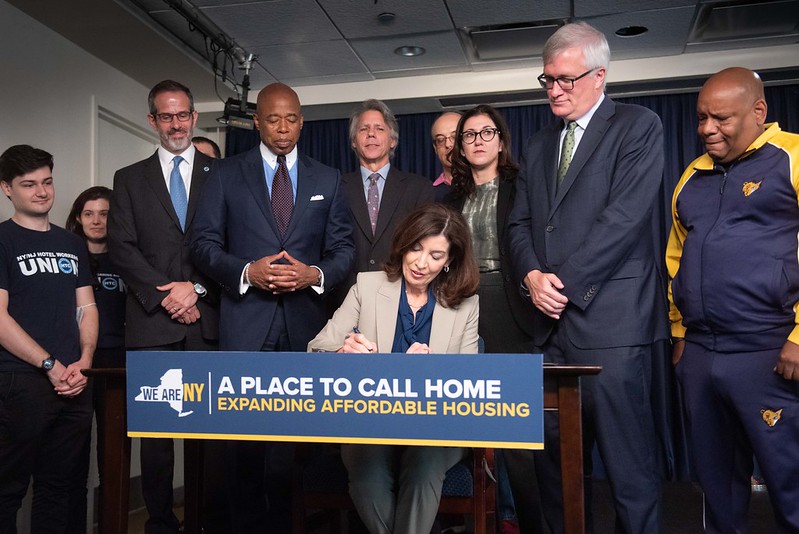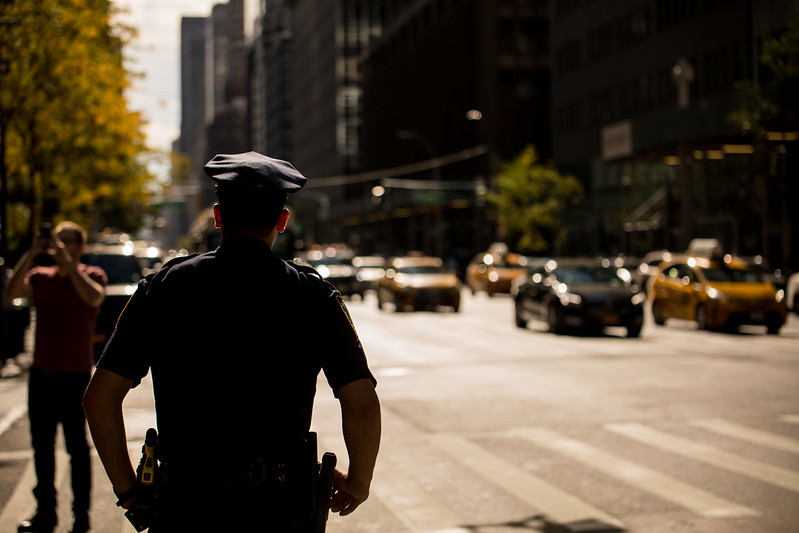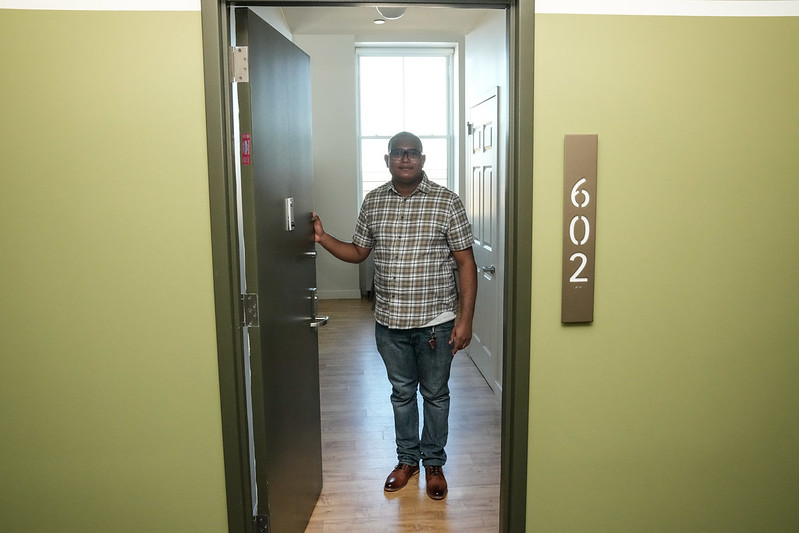Will Office Conversions Actually Produce Affordable Housing? They Should, But State Leaders Must Act

Gov. Hochul signs a bill for hotel to housing conversions (photo: Michael Appleton/Mayor's Office)
In 2016, the City Council adopted mandatory inclusionary housing (MIH), city legislation requiring for the first time that in any rezoning or other regulatory change that created or expanded the right to build apartments — in a neighborhood, or in a single building — at least 20% of the new housing had to be affordable, and affordable in perpetuity.
The foundational concept was simple: if government gives a developer the ability to build more residential units, it is entitled to ask in return for a guarantee that the project will include the mix of incomes that makes the city’s neighborhoods thrive. Prior policies of incentivizing new affordable housing, either through zoning or tax programs, simply had not generated anywhere near the number of units necessary to keep up with demand or promote diverse neighborhoods. With the market continuing to build as many market-rate apartments and luxury condominiums as possible, we knew our city could no longer claim to be a city for everyone if we did not change the rules of the game.
We co-authors had different perspectives from our varied perches — one of us an advocate and nonprofit leader, one the City Council’s chair of the zoning committee, and one the city’s housing commissioner (who worked alongside the deputy mayor for housing and economic development and the chair of city planning). But we all agreed upon one thing: MIH would set a new standard — a floor, not a ceiling, for affordable residential development.
Fast forward seven years. The city was the center of a global pandemic that destroyed families, wiped out people’s livelihoods at an unimaginable scale, and emptied out hundreds of once-bustling business district buildings as office workers went remote. And yet despite the job losses and reports of people leaving the city in droves, rents keep rising and there are even fewer apartments available for low- and moderate-income families. We have a very long way to go on the road to a truly equitable recovery.
But as the state and city lay out plans to make it much easier to convert underused commercial space to residential units, which the city estimated could house tens of thousands of New Yorkers, the notion of mandating affordability has fallen by the wayside. Indeed, the commercial buildings that have already been announced as in the process of converting to residential uses include only market-rate condos and rentals with no affordable units.
Legislation being considered as part of Albany’s big budget package, likely wrapping up in less than a week, would expand the right for developers to convert buildings from commercial to residential — but with zero requirements for permanently affordable units.
The areas that will primarily be affected by the state proposal — downtown Brooklyn, downtown and midtown Manhattan, and Long Island City — currently have very few affordable apartments that middle- and low-income New Yorkers could ever dream of renting. We know that it is expensive and difficult to convert offices to apartments. But we also know it is expensive and not pragmatic for the state and city to be solely responsible for building affordable housing.
We established seven years ago that incentives are no substitute for requirements. We also know from the MIH experience that adding requirements for affordability will not stop construction. More than 10,000 permanently affordable MIH apartments had been approved, with more than 4,000 already completed or under construction, by the end of 2021. Further, because of MIH, high-end neighborhoods like Chelsea/Clinton, Brooklyn Heights/Fort Greene, and Gowanus have already added, or have plans to add, thousands of new homes for low- and middle-income families.
So if New York passes a law that will end up producing thousands of luxury apartments that only the wealthiest can afford, and resulting in zero permanently affordable homes for hard-working regular New Yorkers, then what will we have done?
The solution isn’t rocket science. The city’s MIH requirements must be included in any state legislation that expands rights to commercial to residential conversions.
***
Vicki Been is a former New York City Deputy Mayor for Housing & Economic Development and Commissioner of the New York City Department of Housing Preservation and Development. David Jones is President & CEO of the Community Service Society of New York. Donovan Richards is Queens Borough President and a former member of the New York City Council.
***
Have an op-ed idea or submission for Gotham Gazette? Email This email address is being protected from spambots. You need JavaScript enabled to view it.
Albany: Don’t Tie Our Hands Behind Our Back When It Comes to Fighting Auto Theft and Fraud

On the beat (photo: Benjamin Kanter/Mayor's Office)
With crime continuing to rise in many parts of the state, those of us in law enforcement are doing everything we can to keep people and property safe and secure. And we’ve seen some recent success, especially around reducing gun violence.
But on Long Island, in New York City, and elsewhere, much of the increase is being driven by property crimes, like auto theft.
And yet, despite this worrisome increase, our elected officials in Albany are considering a proposal in the state budget that would gut an important auto-theft-prevention regulation that’s been on the books since the late 1970s and make it harder for those of us in law enforcement to do our jobs.
When an owner of a used car is seeking both collision and comprehensive insurance for the first time, Regulation 79 requires a vehicle photo inspection to be completed within 14 days of the effective date of the insurance coverage. This requirement, for about 8% of used vehicles, covers the small subset that are most likely to be involved in theft or fraud according to data kept by the entity responsible for maintaining the Regulation 79 database. (When the owner is renewing insurance or buying a new vehicle, there is no need to have the car photographed before getting insurance.)
If a car is covered by the Regulation, the owner takes it to one of 3,500 authorized inspection centers around the state. There, a professional will take several photos of the vehicle, including of the VIN sticker, and upload them to the central database to demonstrate that there is no pre-existing damage and the VIN sticker has not been tampered with. This ensures that the car is not stolen nor does it have pre-existing damage that the owner can later claim is new damage, thus committing insurance fraud.
By narrowly targeting the vehicles that are most likely to be stolen or involved in insurance fraud, the regulation helps my colleagues and I fight fraud and theft. If suspicious cars turn up in the database, they are flagged. In 2013, a major auto theft ring was brought down in this way. And if the photos show pre-existing damage, insurers know not to pay out claims for the damage. This in turn means that auto insurance premiums are lower for everyone.
A similar bill that made inspections optional was passed in Albany last year and Governor Hochul wisely vetoed it, observing that the program has “driven down cases of insurance fraud and helped keep rates down for consumers.” Her veto memo said gutting the program would most harm “customers in urban areas who already pay high insurance rates” and who “would likely see their insurance rates increase as a result.”
Indeed, this program has been proven to work. When it was first implemented - during a time of rampant crime - auto theft declined by 7% in New York while increasing in neighboring states.
Proponents of the change in the insurance industry argue that it’s too difficult for customers to get their cars inspected within the two-week grace period. If that’s the case, then maybe the program should be tweaked, as it has been five times in the past. But if we get rid of this program entirely, fraud and theft will increase - driving up costs for people who play by the rules.
When Massachusetts eliminated its program, inspections dropped by about 87%, and collision claims climbed about 55% with premiums spiking by 61%, according to data from CARCO Group, which conducts inspections, and Verisk, another company involved in this work. It wasn’t that Massachusetts residents suddenly became worse drivers, it’s that criminals know how to commit crimes when nobody's looking.
New York shouldn’t follow Massachusetts’ lead. Our program has worked well to protect New York’s consumers. If it needs a tweak so that it’s more user-friendly, that’s fine. But if it’s eliminated, New Yorkers will pay the price.
***
John Becker is President of the Suffolk County Deputy Sheriffs PBA.
***
Have an op-ed idea or submission for Gotham Gazette? Email This email address is being protected from spambots. You need JavaScript enabled to view it.
This Holy Season, State Leaders Should Redouble Efforts to Combat Chronic Homelessness with Supportive Housing

At home (photo: Michael Appleton/Mayor's Office)
This is a holy time for many New Yorkers. Easter, Passover, and Ramadan, all observed this time of year, include important lessons about our collective duty to care for the least fortunate among us.
The number of individuals who need that help is growing. Officials across the state are grappling with how to address a homelessness crisis of epic proportions.
Multiple studies have shown that the best tool available to combat chronic homelessness is to provide individuals not only with a roof over their heads, but on-site services like mental health and substance use counseling to ensure that they can stay safely housed long-term.
New York pioneered this supportive housing model, launching innovative and cutting-edge programs in the early ‘80s that brought together faith leaders, social service providers, and nonprofit organizations in a unique and never-before-seen collaboration. But as the need for more supportive units grows, developing them is becoming more difficult – and expensive.
In 2016, the state made an historic commitment to develop 20,000 supportive apartments by 2031 by way of the Empire State Supportive Housing Initiative (ESSHI). But the price tag for building, land acquisition, labor, and supplies has risen exponentially since then.
The cost of maintaining existing supportive housing developments has risen too, but the state’s funding rates have not kept up, essentially rendering ESSHI obsolete — especially in New York City, where close to 69,000 individuals – including more than 21,000 children — sleep in municipal shelters every night, and thousands more are on the streets, in parks, and in the subway system.
It is imperative to the future of the ESSHI program that state lawmakers and the governor this year raise the per-unit rates for services and rent subsidies from $25,000 per unit to $35,000 per unit. The total cost to the state of this important investment would be just $14 million a year – a small fraction of the $227 billion executive budget Governor Kathy Hochul proposed.
The difference would be immediate and palpable: jumpstarting the development of both supportive and affordable housing. Governor Hochul has already recognized the desperate need for more affordable housing, announcing a strategy to build 800,000 new homes over the next decade.
Catalyzing the creation of more ESSHI units is especially needed for certain groups of people who otherwise would not qualify for this housing. The program uniquely allows nonprofits to build housing for families escaping domestic violence and for individuals re-entering society after incarceration. For both these extremely vulnerable populations, ESSHI is the only option for safe, stable housing with wrap-around services.
The impact of supportive housing for families escaping domestic violence is incalculable. The ability to quickly access a new place to live and the services necessary to stay housed is key to the success of victims seeking to start a new life – for parents and children. And providing supportive housing for a formerly-incarcerated individual is vastly more affordable to the taxpayers than the cost of keeping them behind bars: $1,500 per person, per day at Rikers Island, according to the New York City Comptroller’s Office.
Supportive housing enables individuals and families to rebuild their lives in dignity and safety. It also can help transform formerly blighted and underutilized buildings and underdeveloped lots, providing a broader benefit to the local community.
It is fortuitous that this holy season – a time of rebirth and recommitment to the tenets of kindness and caring for those less fortunate than we are – coincides with the closing days of debate over the state budget in Albany. It is our fervent hope that lawmakers and the governor take this opportunity to do what’s right and invest in supportive housing – a proven model that has the potential to make an even bigger difference for the people who need it and our entire state.
***
The Rev. Ann Marie Witchger is Associate Rector and Chief of Staff at the Church of the Heavenly Rest on the Upper East Side. Evan A. Davis is chair of the church’s Homeless Working Group and was chief counsel to Governor Mario M. Cuomo.
***
Have an op-ed idea or submission for Gotham Gazette? Email This email address is being protected from spambots. You need JavaScript enabled to view it.




